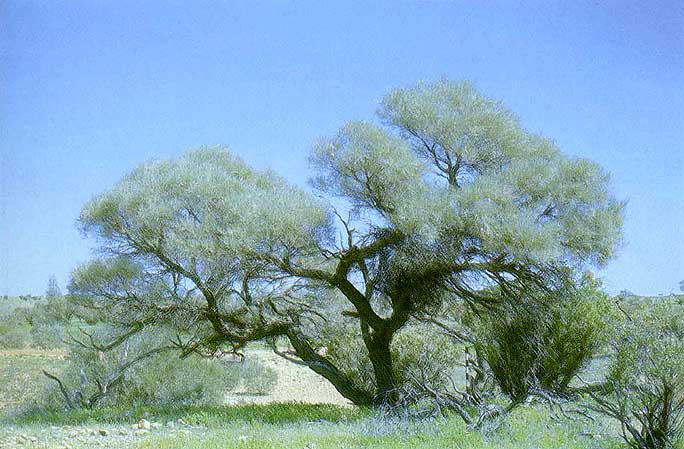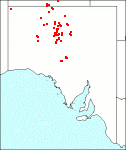Family: Fabaceae
Acacia calcicola

Derivation: calx (L.)—lime, limestone; colo (L.)—to inhabit; referring to the occurrence of this species on soils of a calcareous nature,
Synonymy: Racosperma calcicola (Forde & Ising)Pedley, Austrobaileya 2:346 (1987).
, Acacia coriacea Common name: None
Description:
Rounded shrubs or small, straggly trees 3-5 m high, often as many as six main stems branching from the base and developing a spreading, bushy canopy, often wider than high; branchlets angular with a dense, silvery-grey pubescence; bark grey-black, thick, rough and fissured on main stems.
Phyllodes linear lanceolate often falcate, 5-11 cm long, 4-7 mm broad, coriaceous, dull green with silvery appressed hairs, young shoots silky golden or bronze coloured, many obscure parallel longitudinal veins, 1-3 more prominent, apex more or less uncinate; glands small, basal.
Inflorescences in axillary racemes much shorter than phyllodes, raceme axis densely appressed pubescent with 2-4 heads (sometimes solitary) extending and forming a repetition of phyllodes and peduncles; flower-heads globular, yellow, 30-40flowered; peduncles stout, pubescent, 3-7 mm long; flowers 5-merous (sepals free).
Legumes narrowly oblong, 5-12 cm long, c. 6 mm broad, straight or curved, thick, woody, raised and wrinkled over the seeds, hoary, margins slightly thickened, constricted. Seeds longitudinal in legume, ellipsoid; funicle filiform, short, usually with 1-2 folds and thickened into a pale yellowish fleshy aril at the end of the seed.
|
|
Distribution:
|
In arid area from Gairdner-Torrens (northern part), North-Western and Lake Eyre regions to the N.T. border. It forms small patches mainly in tall open shrubland associated with Acacia aneura, A. kempeana and Casuarina cristata; can also be found along creek banks associated with Eucalyptus camaldulensis. Soils; associated with calcareous soils, mainly crusty alkaline and neutral red duplex, brown calcareous or neutral red earths. Rainfall 125-200 mm. Also N.T., south of the 21( latitude Qld. (Gregory South) and on Mount Stuart in the north- western corner of N.S.W.
S.Aust.: NW, LE, GT.
|
Flowering time: August — December.
|

SA Distribution Map based
on current data relating to
specimens held in the
State Herbarium of South Australia
|
Biology:
No text
Related taxa:
Acacia calcicola was previously confused with A. coriacea (sp. 94) before being described by Forde and Ising in 1958. Acacia coriacea can be distinguished mainly by its longer, linear phyllodes, its longer more slender peduncles and by its longer, curved, twisted and striate legumes of a fibrous texture. A. cana Maiden is also closely related but occurs in N.T., Qld and N.S.W., not S.Aust.
Taxonomic notes:
Three mistletoes have been recorded on A. calcicola of which Amyema preissii, wire-leaved mistletoe is slightly more common than A. maidenii, pale-leaved mistletoe, with a single record of Lysiana exocarpi, harlequin mistletoe.
Cultivation:
A hardy drought-resistant species suitable for planting in calcareous soils in inland areas for shade and windbreaks. Moderate growth rate.
Author:
Not yet available
Source:

|

